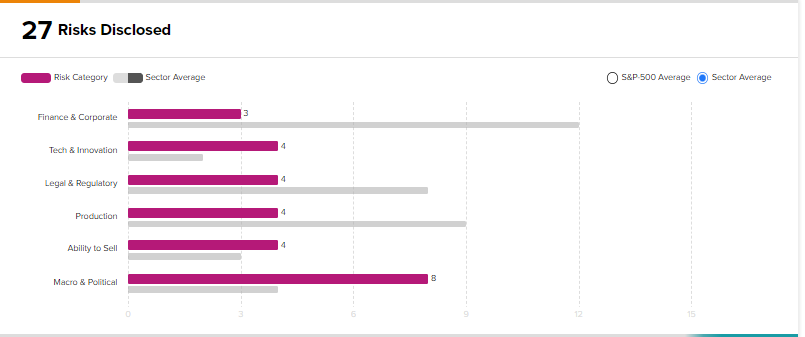The first quarter of 2022 was a roller-coaster ride for the U.S. stock market. Sentiments, which were shaken by a broken supply chain and cost inflation, were further weakened by the outbreak of the Ukraine-Russia war.
Moments of enthusiasm, however, came in when the corporate results announced in the quarter showed some resiliency to component shortages and high costs. The Federal Reserve’s hike in interest rates was a relief for many finance companies. Growth in the country’s GDP, industrial production, and new job additions were other reasons to rejoice.
Amid the aforementioned headwinds and tailwinds, the S&P 500 lost nearly 5% in the first quarter. Interestingly, despite the index’s fall, the energy sector within the group rose a whopping 37.7% in the quarter, as per the U.S. Equities March 2022 report.
The energy sector’s astounding gains make it quite evident that oil companies have solid growth potential and can be of interest to investors seeking exposure to the U.S. equity markets.
Using the TipRanks Stock Comparison tool for the Oil Stocks category, we have narrowed our discussion to two mega oil companies, Exxon Mobil Corporation (NYSE: XOM) and Chevron Corporation (NYSE: CVX).

Exxon Mobil
The $354-billion company explores and produces oil and natural gas as well chemical products. It is headquartered in Irving, TX. Over the past year, shares of this integrated oil & gas company have surged 51.1%.
In the fourth quarter of 2021, the company’s earnings increased to $2.05 per share from the year-ago earnings of $0.03 per share. Revenues and other income increased 82.6% year-over-year. Costs grew 0.1% from the year-ago quarter while expanding 14.1% sequentially.
Going forward, Exxon is poised to benefit from its robust production and refining capacity, technological expertise, cash flows, efforts to exit non-strategic businesses, and synergies from acquisitions, including BioJet AS and others. Project in Guyana, investments in lower-emission solutions, and sound capital allocation policies add more vigor to the stock.
Exxon’s Chairman and CEO, Darren Woods, said, “We’ve made great progress in 2021 and our forward plans position us to lead in cash flow and earnings growth, operating performance, and the energy transition.”
Last week, Biraj Borkhataria of RBC Capital reiterated a Hold rating on Exxon with a price target of $90 (7.31% upside potential).
Meanwhile, another analyst, Doug Leggate of Bank of America, maintained a Buy rating on Exxon with a price target of $120 (43.08% upside potential). The analyst increased its cash flow projection for the first quarter to “$15.3bn vs. a prior $14.5bn and implies organic FcF in excess of $10.5bn.”
Overall, the company has a Moderate Buy consensus rating based on 10 Buys and 13 Holds. Exxon’s average price target of $89.59 suggests 6.85% upside potential from current levels. The stock gets a 7 out of 10 on TipRanks’ Smart Score rating system.
News and Bloggers’ sentiments are Bullish on the stock. The TipRanks Risk Analysis tool suggests that XOM’s main risk category is Macro & Political, which accounts for eight of the total 27 risks identified for the stock.

Chevron
This integrated oil & gas company has a market capitalization of $325 billion. Besides exploration and production of natural gas and oil, the company provides technology, insurance, cash management, and other services. Over the past year, shares of this San Ramon, CA-based company have grown 62.7%.
In the fourth quarter of 2021, Chevron’s adjusted earnings were $2.56 per share, above the year-ago figure of $0.16 per share. Revenues and other income in the quarter expanded 90.6% year-over-year.
Chevron is poised to benefit from growth projects like the Wellhead Pressure Management project and the Anchor project, and solid proved reserves. Its shareholder-friendly policies, acquired assets, capital and exploratory expenses, and joint ventures are likely to be advantageous.
The company’s Chairman and CEO, Mike Wirth, said, “We’re delivering greater value to stockholders today, while working to meet the world’s growing energy demands in a lower carbon future.”
Last week, RBC Capital analyst Biraj Borkhataria maintained a Buy rating on Chevron with a price target of $160 (3.21% downside potential).
Further, Giacomo Romeo of Jefferies reiterated a Hold rating on Chevron while increasing the price target to $146 (11.58% downside potential) from $115.
The company has a Moderate Buy consensus rating based on 15 Buys, eight Holds, and one Sell. Chevron’s average price target of $164.63 mirrors downside potential of 0.56% from current levels. It scores a 9 out of 10 on TipRanks.
News and Bloggers’ sentiments are Bullish on Chevron. Also, Hedge Fund holdings have increased on Chevron in the past quarter.
Chevron shares are exposed to risks mainly from the Legal & Regulator category, which contributes five risks to the total 14 risks identified for the stock.

Conclusion
The Annual Energy Outlook report (published by the U.S. Energy Information Administrative in March) projects that the U.S. economy will satiate its energy needs mostly by consuming natural gas and petroleum through 2050.
An impressive gain in production and prices of oil and natural gas are predicted for 2022 by the federal agency. The ongoing Ukraine-Russia conflict is a major driver behind heightened price projections.
With such strong industry fundamentals, both Exxon and Chevron seem to be good stocks in the long term.
However, Chevron’s Smart Score on TipRanks, more bullish ratings by analysts, and a relatively favorable risk profile make it a preferred energy stock over Exxon in the quarters ahead. Price dips in the stock can be used to gain exposure to Chevron.
Discover new investment ideas with data you can trust.
Read full Disclaimer & Disclosure










